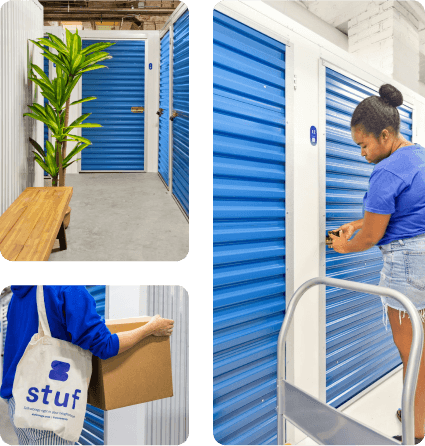In storage, time isn’t gentle, especially when it comes to clothes. If you’re not careful, even premium fabrics won’t hold up against creases, warping, fading, and pest or moisture infiltration. This is why a solid strategy is not only optional, but essential when it comes to keeping your clothes in storage units long-term.
If you want to keep your clothes as fresh as the day you put them in storage, this guide is for you. We’ll walk you through the best way to store clothes long term step by step, so your wardrobe stays fresh, clean, and ready to wear, no matter how long it’s out of sight.
But before anything else, here are a few things you’ll need:
- Mild, scent-free detergent
- Stain remover or spot cleaner
- Lint roller or fabric brush
- High-quality storage containers
- Silica gel packs or moisture absorbers
- Cedar blocks, lavender sachets, or pest-repelling strips
- Acid-free tissue paper
- Label maker or masking tape and marke
- Clean cotton sheets or fabric covers
.jpg?width=302&height=1364&name=Infographic%20(1).jpg)
Step #1: Sort and declutter your wardrobe before storing your clothes
The first and most overlooked step in long-term clothes storage is deciding what actually belongs in storage. Storing items that are already damaged, outdated, or ill-fitting only takes up space and increases the risk of future damage to your more valuable pieces.
If you’re unsure where to begin, I recommend you start with sorting your clothes by category (e.g. jackets, pants, long-sleeves). This will help you spot duplicates and assess usage. Once they’re sorted, evaluate each item based on frequency and fit. If you haven’t worn it in more than six months or if it doesn’t fit anymore, it’s worth reconsidering.
Don’t forget to look for fading, loose seams, pilling, stretched fabric, or missing buttons, and ask yourself honestly if you’d still wear it even after repairs.

Decluttering more than clothes? Here are some of the best tips to declutter your home like a pro.
Donate, recycle, sell
The best way to part with once-beloved clothes is to give them a chance at a new life by either donating, recycling, or selling them.
- Donate items in good condition to charity, such as the Salvation Army or a specific local cause, like a homeless shelter
- Sell near-new condition items online or at local thrift stores
- Recycle stained, torn, and items in such poor shape into rags which you can use at home or also donate. You can also take them to stores like H&M, The North Face, Levi’s, and Madewell to be recycled (qualify for discounts while you’re at it).
Step #2: Wash and Dry Clothes Thoroughly to Prevent Long-Term Damage
Storing unwashed clothes is one of the fastest ways to ruin them. Even if a garment looks clean, invisible residues like body oils, deodorant, skin cells, or minor spills can oxidise over time. These residues can cause yellowing, set-in stains, or even attract pests.
Taking time to properly clean and dry clothes is one of the best ways to store clothes long-term and have them come out like they’re still new
Tips for washing clothes before storage
- Follow care labels: Use the recommended washing method for each fabric type
- Avoid strong fragrances: Scented detergents may fade over time and leave behind chemical residues that deteriorate fabrics or attract pests.
- Treat stains: before washing. Stains that are “washed in” become nearly impossible to remove after storage.
- Avoid fabric softeners: Softeners can leave behind a waxy coating that attracts dust and may weaken natural fibres over time.
- Use distilled white vinegar as an antibacterial: Add ½ cup of vinegar during the rinse cycle (especially for cottons and synthetics). It acts as a natural antibacterial agent, which can extend freshness in storage.
Tips for drying clothes before storage
- Air-dry garments completely: Make sure seams, armpits, and waistbands are bone-dry before packing.
- Avoid overdrying in heat: High heat weakens fibres and can make certain fabrics brittle. If using a dryer, stick to a low heat or delicate setting.
- Let clothes "rest" post-drying: After drying, allow garments to sit for an hour before folding or packing. This ensures heat, humidity, and internal moisture fully dissipate.
Repair any damaged clothing
If you’re handy with a needle, patch up any holes or sew on any missing buttons to your damaged items. For minor repairs, there are even various ways to mend your clothes without a needle and thread.
If those options are out of the question, you can also take them to a local seamstress.
Step #3: Use the Best Containers for Long-Term Clothes Storage
Long-term storage introduces environmental risks that aren’t present in your everyday wardrobe, including fluctuating temperatures, limited airflow, and months (or years) without oversight. That means clothes need both physical protection and a stable internal environment in your storage unit.
The best way to protect clothes in long-term storage is to choose storage containers that protect against dust, humidity, pests, and physical strain.

Best clothes storage containers and when to use them
-
Plastic bin
Plastic bins with tight-fitting lids Plastic bins with tight-fitting lids offer solid protection against moisture fluctuations, insects, and physical compression, especially when they’re made of durable materials and stacked carefully.Transparent versions add extra practicality, allowing you to identify contents at a glance without opening them.
-
Acid-free garment boxes
For garments with sentimental or monetary value, such as vintage pieces, wedding dresses, or delicate silks, acid-free garment boxes are the gold standard. These archival-grade boxes are designed to preserve textiles over time without leaching chemicals. -
Vacuum-sealed storage bags
Vacuum-sealed storage bagsare excellent space-savers and provide a high level of protection from dust and pests, especially for bulky items like synthetic jackets or athletic wear. However, they should be used with care. Natural fibres like wool or silk can suffer under compression, and long-term use may leave permanent creases or damage to structured garments. -
Fabric bins
Fabric storage bins are lightweight and collapsible. While not moisture-proof, they’re excellent for short-to-mid-term storage of less sensitive items, especially in climate-controlled units.Pro tip: Look for bins with reinforced sides and zip closures to better protect against dust and pests.
-
Garment bags or suitcases
Breathable fabric garment bags, like cotton or muslin, protect against dust while allowing airflow, which is essential for materials like wool and silk. These are especially helpful for short to mid-term storage of items you don’t want to be folded.Meanwhile, suitcases are great for multi-purpose storage, especially for less sensitive clothing. However, if you’re using a suitcase, avoid direct contact between the clothes and any synthetic lining. Line the interior with clean cotton sheets or acid-free tissue paper to create a gentler environment.
Storage containers to avoid
- Cardboard boxes
Cardboard is porous and can easily absorb moisture from the air, creating a perfect environment for mold and mildew to develop. It’s also an open invitation to pests like silverfish and rodents, which are known to chew through cardboard and destroy fabric -
Non-breathable plastic bags
Non-breathable plastic bags, like garbage bags or supermarket bags, should also be avoided. They trap humidity and restrict airflow, putting your clothes at risk of yellowing, odor build-up, or mildew.Worse, they can cause permanent creases and fabric warping, especially when stacked or left undisturbed for months at a time.
Step #4: Fold, Pack, and Layer Clothes Properly to Prevent Damage
How you pack your clothes is just as important as where you store them. Improper folding or haphazard layering can lead to permanent wrinkles, fabric stretching, and even mold growth, especially during long-term storage.
Here are some fabric-specific tips:
- Cotton T-Shirts & Basics
Fold flat in thirds or halves to avoid over-stressing seams. Stack neatly with similar-weight garments to prevent distortion. - Wool Sweaters
Fold loosely and flat, and avoid hanging at all costs as gravity will stretch the fibers. Use acid-free tissue paper between folds to reduce friction and preserve shape. - Silk Blouses or Dresses
Lay flat and place a sheet of acid-free tissue paper between each fold. Avoid sharp creases, which can become permanent on delicate silk. - Linen Garments
Fold with tissue paper to cushion the naturally stiff fibers and reduce hard creasing. Store in breathable fabric containers to prevent yellowing. - Suits or Structured Jackets
If possible, use garment bags and hang them to retain shape. If folded, use tissue padding at the shoulders and fold in thirds to avoid breaking the structure. - Delicate Knitwear (Cashmere, Mohair)
Fold gently with tissue between layers and store flat in a fabric bin. Never hang, as the fibers will stretch and lose shape.
If you’re maximizing the space of your containers, you can also roll clothes using the army roll. Fold the item in half lengthwise, then roll it tightly from one end to the other, creating a compact cylindrical shape
As for shoes, make sure they’re completely clean and dry first. Then, remove laces, apply leather conditioner to leather items, and stuff them with acid-free paper, shoe trees, or even socks to preserve their shape. You can then put them back into their original shoe boxes or in plastic containers.
Pro tip: It’s best to store shoes, especially leather ones, in climate-controlled units. If not, ensure that they’re far away from any areas susceptible to moisture in your storage unit.
Layer clothes strategically
Place heavier, more durable garments like jeans or jackets at the bottom of the container. Lighter and more delicate items (e.g., silk tops, dresses, or lace items) should sit on top, protected from compression damage.
If you’re storing items in a container without individual compartments, add separation using cotton sheets, pillowcases, or acid-free tissue paper. These materials allow airflow and create a buffer between layers, minimizing the risk of color transfer or snagging.
Don’t overpack
It may be tempting to maximize every inch of space, but overpacking containers creates compression that leads to wrinkling, fabric stress, and reduced airflow, which increases the risk of mildew.
Your clothes should fit neatly, with enough breathing room to allow for air circulation. If you have to press down on the lid to close the container, it’s overfilled.
Step #5: Add Moisture and Pest Protection Inside Storage Bins
To keep your clothes fresh in long-term storage, it’s best to keep them in a climate-controlled unit. At Stuf Storage, you can find several locations that offer this.
Aside from climate-related concerns, moisture and pests can still pose a threat inside your containers. Here are a few tips to prevent this threat from doing any damage:
Use desiccants to cont
Moisture can quietly build up in enclosed spaces, especially when containers aren’t opened for months. Adding desiccants such as silica gel packets, activated charcoal, or baking soda helps maintain a dry microclimate around your clothes.
Pro tip: Always place moisture absorbers near but not on your clothing to prevent spills or stains.
Use chemical-free pest repellents
Certain pests, especially moths and silverfish, are drawn to stored clothing, particularly natural fibers. But traditional mothballs often contain harmful chemicals and leave behind strong odors.
A few safer pest repellent alternatives include cedar blocks or sachets, lavender sachets, or thyme, rosemary, or cloves.
Beyond physical protection, make sure your items are financially covered by including your storage unit in your insurance policy. You can also opt for extra coverage, such asStuf Storage’s Stuf Blue plan (starts at $10/month).
Step #6: Label, Stack, and Store Thoughtfully Inside the Unit
When your storage plan spans seasons or even years, memory alone won’t cut it, so label your containers clearly and consistently. Use waterproof labels and permanent markers and be specific (e.g. “Winter Wool – Sweaters & Scarves” is better than just “Winter Clothes”)
You can also include a quick inventory sheet inside the bin’s lid for easy reference.
Need help staying organized? Read our guide on for tips you can apply across all your bins.
Strack strategically
Yes, vertical stacking saves space, but done carelessly, it can damage your clothes and bins. Follow these tips:
- Heavier bins go at the bottomo prevent crushing more delicate items above.
- Leave space between the walls and bins to allow air to circulate.
- Avoid overstacking to keep containers from warping or collapsing under pressure.
You can also use shelving units if your storage space allows. It’ll improve access and reduce pressure on your containers.
Create a system
Organize bins and suitcases based on how frequently you’ll need the items. Put frequently used items, such as travel or transitional-season clothing, nearer the front. Long-term storage items such as formal wear or specialty coats can go to the back.

Step #7: Set a Maintenance Schedule
Regular check-ins help you keep your clothes fresh in long-term storage while catching small issues like early signs of moisture or pests before they turn into major problems.
A good rule of thumb is to inspect your clothing storage every 3 to 6 months, even in climate-controlled units. If your unit isn’t climate-controlled, aim for every 1 to 2 months, especially during extreme seasons like summer and winter.
Refresh or replace your moisture and pest control measures regularly. And don’t forget to re-fold, refluff, or rotate your items as needed.
What to look for during each visit:
- Signs of moisture (e.g. musty smells, condensation, or fabric dampness)
- Pest activity (e.g. moths, silverfish, or droppings)
- Container damage (e.g. cracks, warping, or loose lids)
- Shifting stacks or bins placed under too much pressure
Step #8: Get Insurance to Protect Your Most Valuable Pieces
Preparing your clothes properly before putting them in storage minimizes the risk of damage in the unit. But getting insurance for your items is preparation for if something goes wrong.
Even in well-maintained storage facilities, risks like fire, flooding, theft, mold, and pests can’t be fully eliminated. By ensuring your storage is covered under your homeowners or renters insurance, you avoid losing potentially thousands of dollars, especially if you have designer, seasonal, or sentimental pieces.
Aside from your homeowners insurance policy, you can also purchase a standalone storage insurance policy like Stuf Storage’s optional additional insurance policy. Starting at $9/month, you can guard against worst-case scenarios.
FAQs
How do you keep clothes from getting musty in storage?
Use breathable containers, moisture absorbers (like silica gel), and ensure clothes are 100% dry before packing.
Can you store clothes in vacuum bags long term?
Only for short-term use. Long-term compression can damage fabric fibres and trap moisture.
What’s the best way to store clothes to prevent mold?
Store in a cool, dry place with airflow. Add desiccants and avoid plastic bags that can trap humidity
Should clothes be ironed before long-term storage?
Yes. Ironing removes moisture and helps prevent set-in creases and mildew.
How do you keep bugs out of stored clothes?
Wash items thoroughly before storage, use airtight containers, and place natural repellents like cedar or lavender sachets.
Can I store clothes in plastic containers in a hot garage?
Not recommended. Extreme heat can degrade fabrics and encourage mould growth if moisture is present.
Do you need to wash clothes again after storage?
Not always, but a quick refresh wash is ideal, especially if the clothes were stored for 6+ months.
How long can clothes stay in storage without damage?
With proper prep, clothes can be safely stored for years. But check them every 6–12 months.
What materials should never go into long-term storage?
Avoid leather and fur unless professionally packed. They need specialised climate control.
Store Smarter: Protect Your Clothes for the Long Haul
Long-term clothing storage doesn’t have to be complicated, just strategic. From washing and folding to choosing the right containers and preventing moisture buildup, a little prep goes a long way.
For city dwellers and renters looking for secure, clean, and modern storage spaces, Stuf Storage offers climate-controlled units designed for exactly this kind of care. With convenient locations and a tech-enabled experience, it’s the smarter way to store what matters.
Find a unit near you now!
.png?width=1038&height=318&name=Frame%20137%20(1).png)








